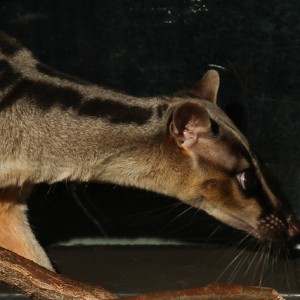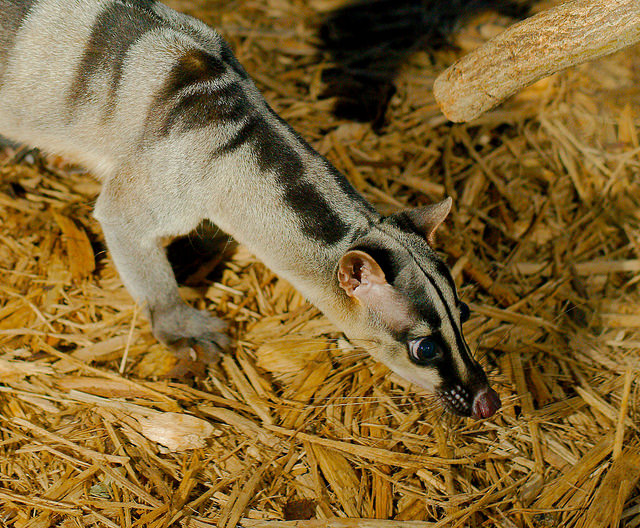The banded palm civet (Hemigalus derbyanus), also called the banded civet, is a rare species of civet found living in tropical jungles and rainforests throughout much of south-east Asia including Burma and Thailand, and throughout most of Malaysia and Indonesia.

Banded Palm Civet Characteristics
The Banded Palm Civet is about the size of a domestic cat, generally measuring from 16 to 21 inches (41 to 51 cm) in total length, and weights from 2.2 to 6.6 lbs (1 to 3 kg).
The banded palm civet has a long pointed face, with a long long body on short legs, There are five toes on each foot with sharp, retractable claws. The hair on its neck points upwards instead of down along the neck. Banded Civet has short, dense fur that is generally a dark cream/buff color with four to five dark bands on its back. Its tail has two dark bands and the latter half of the tail is dark brown to black. There is a dark brown stripe that extends down the length of the top of the muzzle, and two stripes that extend from the top middle of the eye to the inside corner of the ears. There are two areas of white above and below each eye, and the muzzle is darker than the rest of the face. Wikipedia

The banded palm civet has a cat-like appearance and behaves like a cat, but it is not feline. They are more closely related to other small carnivores including weasels and mongooses.
The banded palm civet is solitary nocturnal animal, only making an appearance to hunt and catch food. Though it lives in the forests, it spends much of its time on the ground, although they have been known to climb up into the trees in search of food or to hide from predators, which may include tigers and leopards, large snakes and crocodiles.
The civet is highly territorial and relatively ferocious.
The banded palm civet is a carnivorous animal and can survive on a meat-based diet of rodents, lizards, snakes, frogs and insects. They have also been known to eat the fruits and flowers of palms, mangos and coffee in their natural habitats.

Reproduction
The female banded palm civet usually gives birth to up to 4 young after a gestation period that lasts for a couple of months. The babies are weaned by their mother until they are strong enough to fend for themselves. Banded palm civets can live for up to 20 years, although most rarely get to be this old.
Distribution
Banded palm civets have been drastically affected by increasing deforestation in their native regions, causing much habitat loss. It is listed as Vulnerable because of an ongoing population decline, estimated to be more than 30% over the last three generations, caused by over-exploitation, decline in habitat quality, and habitat destruction and degradation.
Sources for Banded Palm Civet: A-Z Animals, Arkive, and Wikipedia
*
B is for Banded Palm Civet : A-Z Collection of Animals #wildlife Click To Tweet
*
- Mindful Travel With Your Dog This Holiday Season - December 23, 2019
- A-Z of Australia’s Endangered Wildlife - December 20, 2019
- Teaching Your Kids How to Walk the Dog Safely - December 2, 2019


This is one I don’t remember ever seeing anything about before. Thank you for the pics & info on this beautiful creature. It’s rare I find a new one anymore. 😉
Thanks for stopping by, Susan. I appreciate your visit. I’m glad you learned about a new critter today. I love finding out about new ones too. Come back soon, ya hear? 🙂
I love this A-Z idea. Its brilliant. And I have never heard of this animal which is why I love this even more. At first glance it definitely looked like it came from the mongoose family. Very fascinating animal. I am so appreciative of your love for all animals in our world and your diligence in educating those you can. Spectacular blog.
It’s fun doing the A-Z challenge. I’m trying to feature animals that most people would never have heard of, or at least don’t know much about. That way I get to learn too. I love what I do. Thanks for your visit! 🙂
It almost looks too cute to be ferocious! Thanks for all the info. And I love your cover image!
Thank you for stopping by, Yvonne. I’m glad you enjoyed the post and especially glad that you like my cover image. I made it myself. 🙂
It almost looks too cute to be ferocious! Thanks for all the info. And I love your cover image!
Yvonne
Thank you for stopping by, Yvonne. I’m glad you enjoyed the post and especially glad that you like my cover image. I made it myself. 🙂
Hi Jeanne, I’m also doing an animal A-z! I’m a wildlife poet so also poems about the animals, lovely to see someone else animal-mad! I’ll be very interested to see what you choose along the way. I wonder if any of the entries will be the same creature? See you soon, Liz, http://www.lizbrownleepoet.com
Hey, Liz! Nice to meet you! I love reading other animal-lovers posts. I’ll be checking out your site too during the A-Z Challenge. Yes, it would be fun to see if we refer to the same critters. Take care, and I’ll see you around. Enjoy the challenge! 🙂